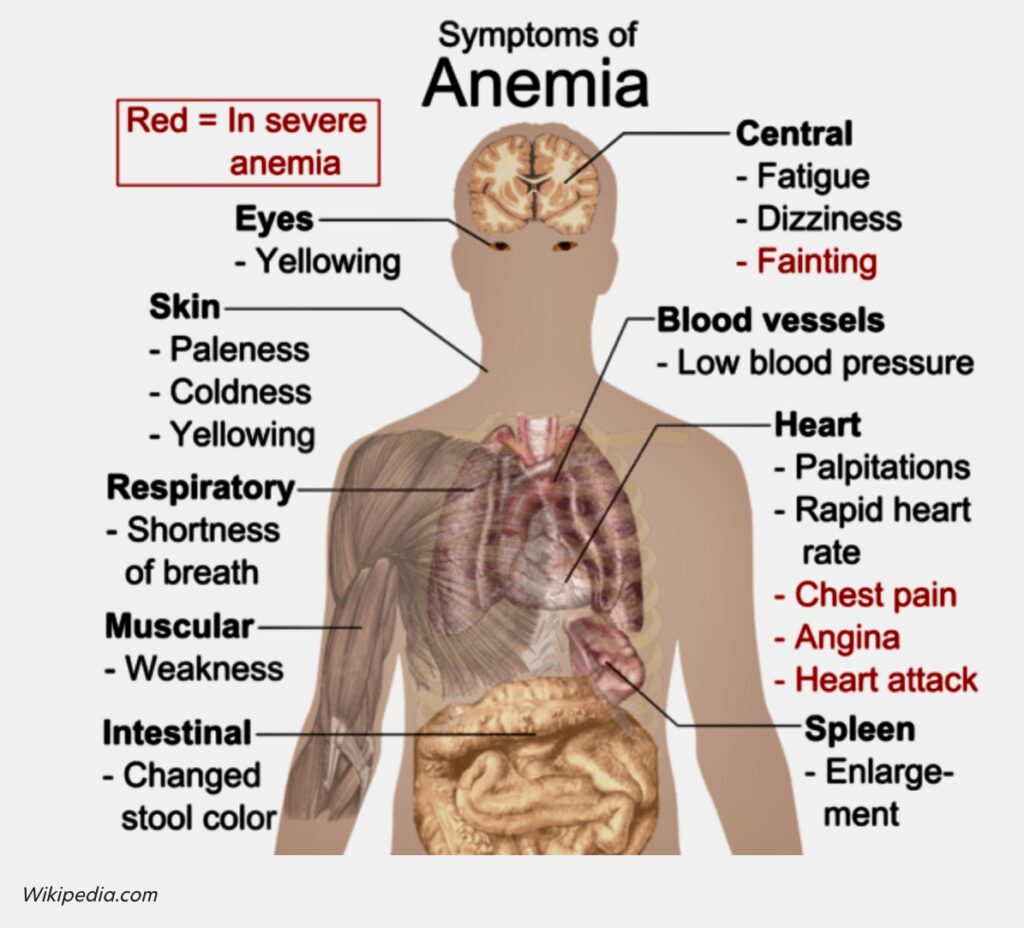By Henrylito D. Tacio
“Anemia is a serious global public health problem,” says the Geneva-based World Health Organization (WHO). It affects 571 million women and 269 million young children around the world, the United Nations health agency points out.
In 2019 alone, anemia affected 40% of children between 6 months and 5 years of age, 37% of pregnant women, and 30% of women 15-49 years or age.
Anemia, particularly iron deficiency anemia and vitamin deficiency anemia, increases the risk of infections and death, impairs cognitive performance, and causes extreme fatigue, poor pregnancy outcomes, loss of earnings, and poor growth and development.
According to the Mayo Clinic, possible symptoms of anemia include: tiredness, weakness, shortness of breath, pale or yellowish skin, irregular heartbeat, headache, dizziness or lightheadedness, chest pain, and cold hands and feet.
Likely to be affected
The Cleveland Clinic says that most of those wnewborns, infants, children, pregnant women, women and people designated female at birth, people age 65 and older, and people with chronic conditions most likely to be affected by anemia.
In a study, prevalence of anemia in the Philippines was reported to be highest among infants aged 6 to 11 months (40.1%), pregnant women (24.6%), elder males (23.0%), elder females (19.1%), and lactating women (16.7%).
“Most work on addressing anemia has focused on the prevention and treatment of iron deficiency, said Dr. Francesco Branca, the director.
“However, this is a complex condition with multiple causes – including other nutritional deficiencies, infections, inflammation, gynaecological and obstetric conditions, and inherited red blood cell disorders,” the WHO official added.
The UN health agency said all these must be addressed to effectively prevent and treat anemia.
What is anemia
It is a condition of not having enough healthy red blood cells carry oxygen to the body’s tissues. Red blood cells are one of the three types of blood that the body makes. While blood cells fight infection while platelets help blood clot.
“Red blood cells have an iron-rich protein that gives blood its red color, called hemoglobin,” the Mayo Clinic explains. “Hemoglobin lets red blood cells carry oxygen from the lungs to all other organs in the body. And it let’s red blood cells carbon dioxide from other parts of the body to the lungs to be breathed out.”
Spongy matter inside many of the large bones, called bone marrow, makes red blood cells and hemoglobin. To make them, the body needs iron, vitamin B12, folate and other nutrients from foods.
Forms and causes
There are many forms of anemia and each has its own cause. The Mayo Clinic lists the following:
Iron deficiency anemia: Too little iron in the body causes this most common type of anemia. Bone marrow needs iron to make hemoglobin. Without enough iron, the body can’t make enough hemoglobin for red blood cells.
“Pregnant women can get this type of anemia if the don’t take iron supplements. Blood loss also can cause it. Blood loss might be from heavy menstrual bleeding, an ulcer, cancer or regular use of some pain relievers, especially aspirin,” the Mayo Clinic explained.
Vitamin deficiency anemia: The body also needs folate and vitamin B12 to make enough healthy red blood cells. A diet that doesn’t have enough of these and other key nutrients can result in the body not making enough red blood cells.
There are people who can’t absorb vitamin B12. This can lead to vitamin deficiency anemia, also called pernicious anemia.
Anemia of inflammation: Diseases that cause ongoing inflammation can keep the body from making enough red blood cells. Examples are cancer, rheumatoid arthritis, kidney disease, Crohn’s disease, and human immunodeficiency virus/acquired immune deficiency syndrome (HIV/AIDS).
Aplastic anemia: This rare, life-threatening anemia occurs when the body doesn’t make enough new blood cells. Causes include infections, certain medicines, autoimmune diseases and being in contact with toxic chemicals.
Anemias linked to bone marrow disease: Diseases such as leukemia and myelofibrosis can affect how the bone marrow makes blood. The effects of these types of diseases range from mild to life-threatening.
Hemolytic anemias: This group of anemias is from red blood cells being destroyed faster than bone marrow can replace them. Certain blood diseases increase how fast red blood cells are destroyed. Some types of hemolytic anemia can be passed through families, which is called inherited.
Sickle cell anemia: This inherited and sometimes serious condition is a type of hemolytic anemia. An unusual hemoglobin forces red blood cells into an unusual crescent shape, called a sickle. These irregular blood cells die too soon. That causes an ongoing shortage of red blood cells.
Accelerate action
Meanwhile, progress on reducing anemia has been slow and the world is not on track to reach the global target. That is why during the launching of its first-ever Comprehensive Framework on Reducing Anemia, WHO is calling on countries to accelerate action to have anemia prevalence in women of reproductive age by 2025. – ###
Sources:
https://www.mayoclinic.org/diseases-conditions/anemia/symptoms-causes/
https://newsinfo.inquirer.net/1672474/blood-diseases-toll-on-thousands-of-filipino-lives
https://my.clevelandclinic.org/health/diseases
http://www.who.int/news/item/12-05-2023-who-calls-for-accelerated-action-to-reduce-anaemia










